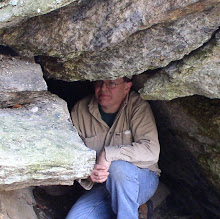With another season quickly on the wane, I was contemplating what to do. A couple odds and ends presented themselves and I took to the road. Heading into the Connecticut River Valley my first destination was Laurel Park former Methodist camp/retreat, now a community of some rather 'unusual' homes. Recently I had obtained a second - different - view of the "Boulder Knoll" within that community. Expanding on what I did here last year I located - and photographed - both present day views of said Boulder Knoll.
Rolling north up the valley and heading a bit east towards the Connecticut River, I ascended into ledges bordering the Mohawk Trail highway. This was to examine the cave formation mentioned to me last year and finally seen a month earlier on my return from Cape Ann. 'Formation' is a good term as it is a niche formed by weathering and subsequent loss of material from the ledge. A similar but larger one has been examined in the past a little over a mile away near an old dinosaur track quarry.
Then the big goal of the day: a return to Erving Castle or the Hermit's Cave. This location is a well known local tale of hermit John Smith taking residence in a shelter cave at the base of high ledges on Hermit Mountain. Hard to believe but it's been ten years since my last visit. My own access is to climb directly from the highway in a rather steep and rugged ascent. Although it's over a hundred years since John inhabited the area, one can still find his 'cave', the Pulpit Rock, the 'gazebo', and a spring. Also present are old walls and a foundation. John, along with his cat Toby, are buried in a nearby cemetery alongside the highway.
Monday, November 24, 2008
Sunday, November 9, 2008
The time of year once again arrived for the jaunt down on into Connecticut for a couple days. The first day was a visitation to the lands of the White Memorial Foundation on the Litchfield-Morris town line. Four thousand acres and something like 35 miles of trails provide much to explore. This day included an observation platform overlooking the bay of a much larger lake. Another section was a remote area of sylvan wilderness with marshes, ponds, a beaver lodge, and a circuit trail through a multitude of glacial boulders with a ledge ascent. The second day was casual walking through the State's capital to see historic monuments, buildings and parks. Very present was the famous "brownstone" quarried just a stone's thrown away, down - and across - the Connecticut River at Portland.
